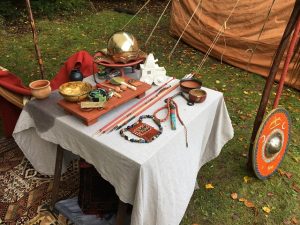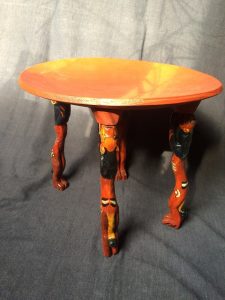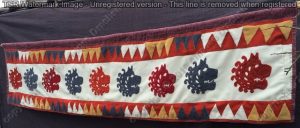Further artifacts and storage accessories
 Here we have put together all objects and reconstructed artifacts that can either be assigned directly to any representation or belong to the storage accessories.
Here we have put together all objects and reconstructed artifacts that can either be assigned directly to any representation or belong to the storage accessories.
 Serving plates from Pazyryk (Pazyryk, wood and paint, 4th / 3rd century BC)
Serving plates from Pazyryk (Pazyryk, wood and paint, 4th / 3rd century BC)
Nomadism requires everyday objects adapted to the mobile lifestyle. This becomes particularly clear with wooden dismountable serving plates, which had the function of small tables. They were designed so that you could remove the legs of the table and so easily assembled and disassembled. There are many finds of these pieces of furniture in nomadic tombs where wood has been preserved.
read on ... Rudenko 1970: 65-68; Pl. 50A / B. read on ... Wieczorek and Lind (2007): 221. read on ... Rudenko 1970: 31f; Pl. 148A. read on ... Rudenko 1970: 192. read on ... Seipel, W. (ed.) (2009): Gold of the Steppe. Treasures beyond the Alexander empire, 289. read on ... Vorzeiten. 70 years State Archeology Rhineland-Palatinate (2017): 180-183. Horn cup Wieczorek and Lind 2007: 157.
 Serving plate from Xinjiang (Sampula, wood and color, Han period 206 BC – 220 AD)
Serving plate from Xinjiang (Sampula, wood and color, Han period 206 BC – 220 AD)
Wooden plates were also common among the nomads of the Tarim Basin. This specimen has only three legs, which could be removed for transport. While searching, the bones of the food ingredients that were put into the grave were still lying on the serving platter.
 Felt wall hanging from Pazyryk I (Pazyryk, wool felt, 4th / 3rd century BCE)
Felt wall hanging from Pazyryk I (Pazyryk, wool felt, 4th / 3rd century BCE)
In various burial chambers from Pazyryk wall hangings made of felt were found, which had colorful motifs. Perhaps the dwellings of the Altai nomads were decorated with such hangings.
One of these hangings comes from Pazyryk I and consisted of a narrow felt base, on which three strips of thinner felt were sewn. The middle, white stripes were decorated with red and blue lion heads made of thin felt. It was hemmed by a red border, on which thin triangular felt applications in white, yellow, red and blue were sewn. The hangings had been hung with wooden and copper nails on the wall of the burial chamber.
We have made a replica of this double curtain for our canopy, as there is a legitimate assumption that the felt trimmings were also used in the daily life of nomads and not just for the funeral rite.
Sembach and Haeseler 1984: 184.
 Swans from Pazyryk 5 (Pazyryk, felt and wood, 4th / 3rd century BC)
Swans from Pazyryk 5 (Pazyryk, felt and wood, 4th / 3rd century BC)
In the burial chamber of Pazyryk 5, four swans of different colored felt and a filling of moss were found. What kind of function these detailed bird figurines once fulfilled is unclear.
Sembach and Haeseler 1984: 216f.
 Wagon-toy (Kerch in the Crimea, clay, 1st-2nd century AD)
Wagon-toy (Kerch in the Crimea, clay, 1st-2nd century AD)
Small miniatures of such wagons appear again and again in nomadic graves, especially those of children. They show how one must imagine the dwellings of the nomads of which ancient writers report.
 Draco standard (Niederbieber, copper, silk, gold and tin, 260 AD)
Draco standard (Niederbieber, copper, silk, gold and tin, 260 AD)
Equestrian standards served as a military order instrument in cavalry units. At first they were used by the cavalry nomads. Through the contact of Rome with the equestrian warriors on the eastern border of the Roman Empire, they first adopted the principle of mounted warfare and then equestrian standards like this one.
This specimen was found in Niederbieber and comes from the once existing fort, which was 260 forcibly destroyed. The standard fell into a pit filling, so that this unique to date find of a dragon standard, on which there are only written and image sources, has been preserved.
The dragon’s head is made of sheet copper, fire-gilt in the upper part (we used gold leaf) and tinned in the lower part. At the back of the standard was once a hose made of lightweight fabric (probably silk) attached, which fluttered in the wind or gallop impressive in the wind.
For the production of everyday commodities, cattle nomads used the raw materials they got from their herds. Therefore, many objects are made of bone, horn or antler. So also drinking vessels such as such Horncups, which consisted of sawed off cattle horns. weiterlesen...
http://hermitagemuseum.com/wps/portal/hermitage/digital-collection/25.+archaeological+artifacts/879947 (last accessed on 10/20/2017)
Parzinger (2006): 601.
